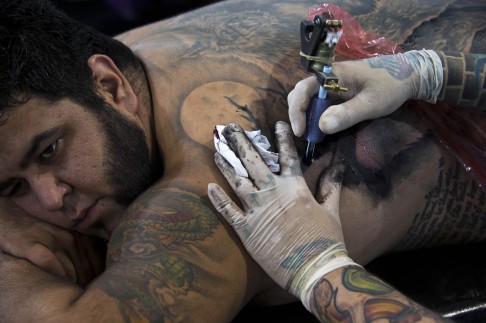
The surprising science of tattoos, from medicinal benefits to how they hijack the immune system

Tattoos might make you feel good. There are the obvious chemical responses, for starters: You’re going to have a rush of adrenaline, because someone is coming at you with a needle. And you’re going to get some pretty nice endorphins too – your body’s chemical response to pain – which can make you sort of high.
But there’s more to it than that. According to one (admittedly small) study, a new tattoo might improve your self-image for weeks after the fact.
The effect might even be long-term for men, though most women in the study got anxious a few weeks in – possibly because they started worrying about how other people saw their tattoos.
Some tattoos might even be medicinal.
There’s evidence that tattoos found on ancient humans may have been deliberately placed over acupuncture points to provide a more permanent therapeutic effect. Even today, some cultures practice medicinal tattooing to cure certain ailments, with the most convincing effects seen in arthritic joints.
Lots of people seem to think that tattoo needles shoot ink into your skin. That’s an understandable misconception. But that’s not how tattooing works. It’s actually all about capillary action. The ink is held between separate tiny needles – the same way ink is held between strands of hair on a paintbrush – and when those needles puncture the skin, the ink is sucked down into your skin. Tattoos become permanent by hijacking your immune system. You’re pretty much duping your entire body when you get inked.
When a tattoo needle punctures your skin, your body does what it does whenever anything punctures your skin and tries to close the holes up. The cells that rush to the rescue arrive to find not just a wound, but also a foreign invader – the ink.
Those cells gobble up the ink, but some of them get stuck in the dermis layer of your skin. When you look at a tattoo, you’re not just seeing little bits of ink trapped under your skin. You’re actually seeing ink trapped inside cells that had hoped to destroy that ink. Those odd bedfellows stay visible pretty much forever, fading and laser removal notwithstanding.
Tattoo ink is a cornucopia of different chemicals. Every tattoo ink is different. If you get two tattoos in the exact same shade, but get them at different times and from different artists, the chemical compositions probably won’t match.
And a lot of artists don’t mix their own inks, but buy them from companies that hold on tight to their formulas, meaning that the person putting ink in you might not know what’s in it. So if you have allergies – especially to heavy metals, which provide the colour for a lot of known ink formulas – take extra precautions.
One survey of New Yorkers found that 10 per cent had skin problems after getting tattoos. When you consider that tattoo ink is basically a mystery, those odds don’t seem so bad. And some of those incidents were no doubt due to improper aftercare. It’s important to remember that your tattoo is an open wound just like any other so follow your artist’s instructions!
Some have even suggested that tattoo inks might be carcinogenic. Because they’re unregulated and vary so much, it’s hard to gauge how much of a real risk this might be.
A lot of people ask where they can get tattooed and have it hurt the least. Bad news, guys: No scientific study to back this one up, but just take my word for it, everyone is different. But the pain of tattooing is just like any other pain: It’s highly subjective.
Many say that it’s the bony areas that hurt the most, but some will swear it’s the fleshier parts of their body where it was really unbearable. Sometimes a tattoo gun will go right over a particularly sensitive nerve. Some people have a better experience when they can see the needle in action (and freak out if they can’t) and others prefer blissful ignorance of its machinations.
You won’t know until you try.
And then you’ll get your second tattoo somewhere else and cry like a baby because you weren’t expecting it to hurt so much more than the first one did. It’s all good.
There are some downsides, like things you can’t do with a tattoo. Laser hair removal, for one. Because the process works by targeting dark pigment, tattoos will end up drawing the laser’s ire and get blistered and burned.
If you’ve got a coloured tattoo, chances are pretty good that the metal content of the ink will be enough to make MRIs ... interesting. The effect of metal inside a tattoo can range from a weird tingling feeling to a painful burn, but neither are any reason to avoid necessary diagnostic imaging. Just be prepared.
And tattoos can even interfere with your ability to adopt new technologies. Apple recently admitted that some users of the brand’s smartwatch wound up disappointed when their wrist tattoos interfered with the device’s sensors.


